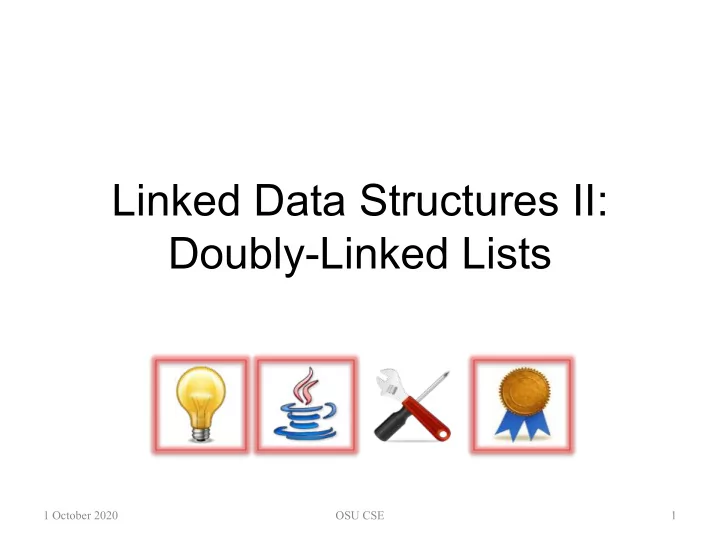

Linked Data Structures II: Doubly-Linked Lists 1 October 2020 OSU CSE 1
Sequential Access • Sequential access usually means accessing the entries of a collection (with a string model) in increasing order of position, by accessing the “next” entry in the collection • Sometimes you can access the entries sequentially in the reverse direction, too, by accessing the “previous” entry in the collection – Example: the OSU CSE components List 1 October 2020 OSU CSE 2
Interfaces and Classes Standard Iterable extends extends ListKernel extends List implements implements … List1L List3 1 October 2020 OSU CSE 3
Interfaces and Classes Standard Iterable extends extends Standard has contracts ListKernel for three methods: clear newInstance extends transferFrom List implements implements … List1L List3 1 October 2020 OSU CSE 4
Interfaces and Classes Standard Iterable ListKernel has contracts for six extends extends methods: addRightFront ListKernel removeRightFront advance extends moveToStart leftLength List rightLength implements implements … List1L List3 1 October 2020 OSU CSE 5
Interfaces and Classes List has contracts for fiveother Standard Iterable methods: rightFront extends extends replaceRightFront moveToFinish retreat ListKernel swapRights extends List implements implements … List1L List3 1 October 2020 OSU CSE 6
Mathematical Model LIST_MODEL is ( left: string of T, right: string of T ) type ListKernel is modeled by LIST_MODEL 1 October 2020 OSU CSE 7
Mathematical Model LIST_MODEL is ( You may think of these two left: string of T, strings as being to the left and right, respectively, of right: string of T the “current position”. ) type ListKernel is modeled by LIST_MODEL 1 October 2020 OSU CSE 8
No-argument Constructor • Ensures: this = (< >, < >) 1 October 2020 OSU CSE 9
advance void advance() • Advances the position in this by one. • Updates: this • Requires: this .right /= < > • Ensures: this .left * this .right = # this .left * # this .right and | this .left| = |# this .left| + 1 1 October 2020 OSU CSE 10
retreat void retreat() • Retreats the position in this by one. • Updates: this • Requires: this .left /= < > • Ensures: this .left * this .right = # this .left * # this .right and | this .left| = |# this .left| - 1 1 October 2020 OSU CSE 11
What’s New? • With just advance , sequential access is only to the “next” position – A singly-linked list representation provides good performance • With retreat as well as advance , sequential access is also to the “previous” position – A singly-linked list representation provides poor performance 1 October 2020 OSU CSE 12
What’s New? To see why, write an • With just advance , sequential access is implementation of only to the “next” position retreat using only the ListKernel methods. – A singly-linked list representation provides good performance • With retreat as well as advance , sequential access is also to the “previous” position – A singly-linked list representation provides poor performance 1 October 2020 OSU CSE 13
Example: List2 (SLL) this = (<18>, <6>) ? 18 6 preStart data data data lastLeft next next next this finish 1 leftLen 1 rightLen 1 October 2020 OSU CSE 14
Example: List2 (SLL) this = (<18>, <6>) ? 18 6 preStart data data data lastLeft next next next this finish 1 leftLen The abstraction function 1 (correspondence) ... rightLen 1 October 2020 OSU CSE 15
Example: List2 (SLL) this = (<18>, <6>) ? 18 6 preStart data data data lastLeft next next next this finish 1 leftLen The “current position” is 1 indicated by this .lastLeft . rightLen 1 October 2020 OSU CSE 16
A Second Smart Node • Note that the code for Queue2 has no special cases at all, but the code for List2 needs to handle a special case in addRightFront and removeRightFront • This can be eliminated by introducing a smart node at the end of the singly-linked list, too, so the two smart nodes are like “bookends” 1 October 2020 OSU CSE 17
A Second Smart Node You should be able to re-write this code for List2 with two smart nodes, as illustrated on • Note that the code for Queue2 has no the next slide. special cases at all, but the code for List2 needs to handle a special case in addRightFront and removeRightFront • This can be eliminated by introducing a smart node at the end of the singly-linked list, too, so the two smart nodes are like “bookends” 1 October 2020 OSU CSE 18
Example: SLL “Bookends” this = (<18>, <6>) ? 18 6 ? preStart data data data data ? lastLeft next next next next this postFinish 1 leftLen 1 rightLen 1 October 2020 OSU CSE 19
Example: SLL “Bookends” this = (<18>, <6>) ? 18 6 ? preStart data data data data ? lastLeft next next next next this postFinish 1 There is really no need for a leftLen null reference any more; 1 ? here means “unused”. rightLen 1 October 2020 OSU CSE 20
Doubly-Linked Lists • In addition to the second smart node, the code for List3 introduces one other (major) change • The data structure is now a doubly-linked list , in which there are two references per node: one to the “next” node and one to the “previous” node – This allows retreat to be implemented efficiently 1 October 2020 OSU CSE 21
Example: List3 (DLL) this = (<18>, <6>) ? ? 18 6 preStart data data data data ? lastLeft next next next next this postFinish ? prev prev prev prev 1 leftLen 1 rightLen 1 October 2020 OSU CSE 22
Resources • Wikipedia: Linked Data Structure – http://en.wikipedia.org/wiki/Linked_data_structure • Big Java (4th ed) , Section 15.2 (but not the part about iterators) – https://library.ohio-state.edu/record=b8540788~S7 1 October 2020 OSU CSE 23
Recommend
More recommend